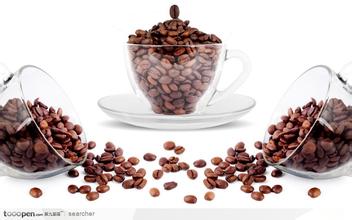What does Chinese coffee trees look like? where are coffee trees planted in Yunnan? environmental production areas manor treatment plants.
What does Chinese Coffee Tree look like? introduction to manor treatment plants in Yunnan where coffee trees are planted in environmental production areas
Coffee fruits should be harvested immediately, and it is not easy to harvest coffee fruits at different ripening stages on the same tree. Generally speaking, it takes as long as 4-5 months to receive a full harvest from the initial harvest. If ripe and immature fruits are harvested at the same time, the quality of coffee will be reduced. Therefore, good quality coffee is picked one by one by hand, in order to maintain the perfect taste of coffee, depending on the region, the harvest time of coffee varies. Regions north of the equator (such as Ethiopia and Central America) are generally harvested from September to November. South of the equator, such as Brazil and Zimbabwe, although the harvest can last until August, the main one is in April or May. Countries in the equatorial region, such as Uganda and Colombia, can harvest all year round, especially those plantations that can make good use of different elevations. As a result, there may be new coffee beans for most of the year. Most Arabica coffee beans mature from June to August, while robastian coffee beans mature from September to October. Therefore, although in some countries where the dry and wet seasons are not obvious, such as Colombia and Kenya, there are two flowering periods a year, that is, two harvests, strictly speaking, only once a year, under normal circumstances, each fruit has two coffee beans, flat opposite to each other. There are also coffee trees that sometimes produce smaller fruits with only one coffee bean in it. This single coffee bean has a different name-peaberry, single bean or perla. It has no flat surface and is almost round. Because its quantity is very small and must be specially selected and collected together, the price is much higher than ordinary coffee beans. Many people think that the taste of round beans is particularly good, because its round bean shape can closely wrap the original flavor of coffee in beans, the taste is very strong, and the mature fruit skin is red, which is regarded as the best in coffee beans. Because the shape and color are similar to cherries, mature coffee fruits are called coffee cherries (coffe cherry) in many places. Under the bright red pericarp, the peel, pulp and a sweet sticky yellow substance wrap the coffee beans.
Before long, small fruits appear in piles, first green, then yellow, then red or crimson, and can be picked almost black. In Jamaica, bats are the first to know whether the fruit is ripe or not. by sucking coffee pulp at night, they are telling people that the fruit is ripe and ready to be picked. The oval fruit gathers tightly around the branches, with slender, smooth dark green toothed leaves on both sides of the branches. The leaves on the sunny side are harder, the back is softer, the edges are fan-shaped, and the branches are opposite from the trunk.
Coffee trees are usually bred in nurseries, grow into seedlings, and then moved to coffee plantations a year later, in full compliance with the original Arab method of planting and cultivating coffee trees. In the first four or five years of its growth, the coffee tree will continue to take root downward, develop its trunk upward, and develop into an umbrella shape so that it can bear rich fruit in the future.

Important Notice :
前街咖啡 FrontStreet Coffee has moved to new addredd:
FrontStreet Coffee Address: 315,Donghua East Road,GuangZhou
Tel:020 38364473
- Prev

Zhongchuang pastoral start-up coffee matchmaking 50 million project settled in Yangling
In Yang Lingzhong Chuangchuang Pastoral, there is a place called Entrepreneurship Coffee, where you can order a cup of coffee and enjoy the free open office environment. You can not only understand Yangling's entrepreneurial preferential policies and environment, but also have the opportunity to collide with other young people with entrepreneurial dreams, and even find investors who are interested in your creative project.
- Next

Historical Flavor description of Coffee planting in China introduction to the characteristics of Coffee varieties produced by Taste treatment
Description of the Historical Flavor of Coffee planting in China the great potential of the coffee market in China can not be ignored. Some international coffee companies have chosen Shanghai as the production base and adopted a long-term strategy to expand the Chinese market.
Related
- Is espresso stored overnight in the refrigerator harmful to your body? Is frozen coffee better than freshly ground coffee?
- What parameters and proportions of water temperature should be used to grind and brew fresh coffee beans? Why can't I drink freshly roasted coffee right away?
- Customers have "changed" Manner's new products! Shop assistant: Please don't mess around!
- Remove sockets in customer areas at Starbucks stores?! Netizen: I won't go if I really tear it down
- What is the difference between the taste steps of sun-dried coffee and washed coffee? Why is sun-cured coffee sweeter and washed coffee sour?
- The recipe for salty grapefruit dirty is revealed! Coffee Festival salty grapefruit dirty coffee making materials parameters ratio milk share!
- How about the flavor of Sunlight 74158 at Sidamo Banshaha Mathieu Processing Factory in Ethiopia? 74158 Share the proportion of coffee brewing parameters!
- What effect does Italian American coffee with filter paper have? Will coffee taste better if it is put on filter paper at the bottom of the powder bowl?
- What is the color difference in coffee beans? What are the characteristics of honey processed coffee beans? Why are the anaerobically treated coffee beans uneven in color?
- How does novice Xiaobai quickly get started and make coffee? Newbies learn to make coffee by hand and share the specific steps and process process!

